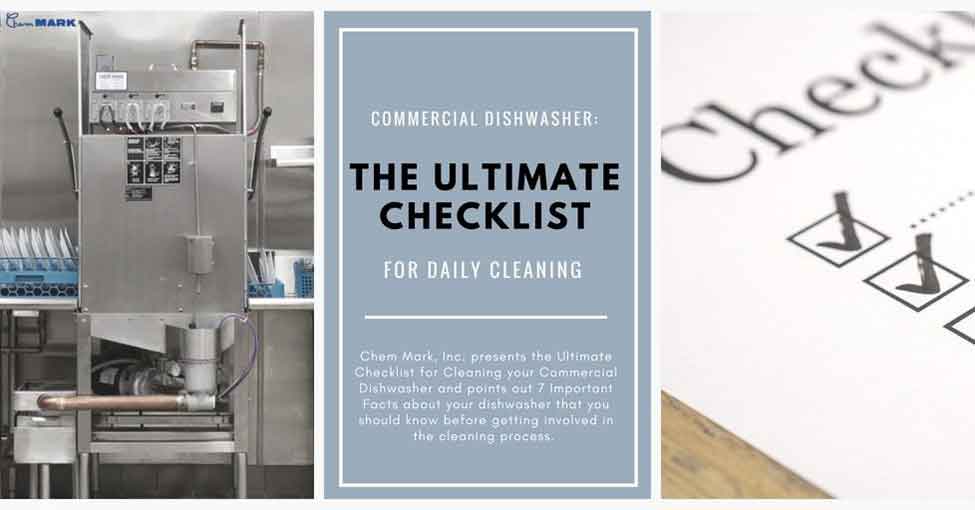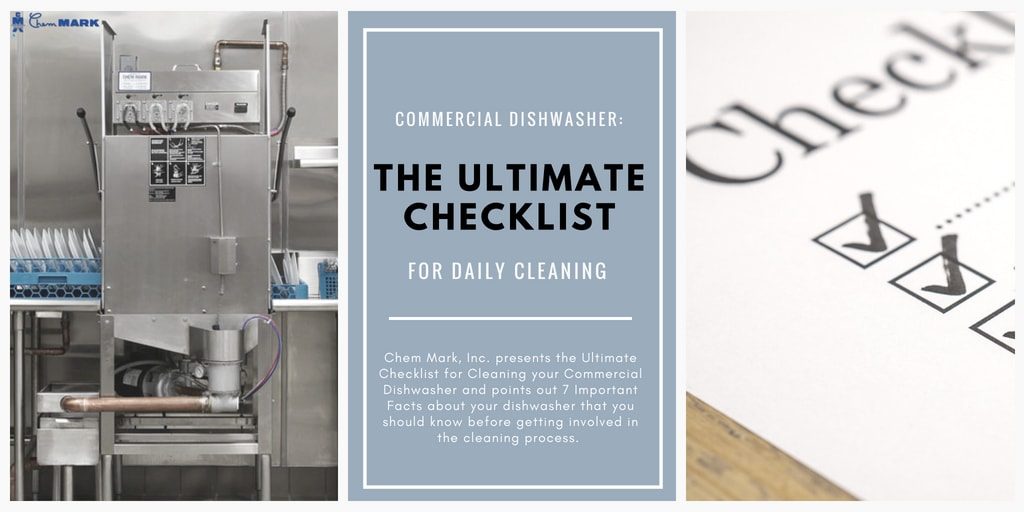Commercial Dishwasher Cleaning Checklist

Yes, a commercial dishwasher is truly an amazing device. Bet you can’t even imagine hand-washing dishes at home anymore, let alone doing it in a busy commercial kitchen. Washing as much as 1,000 racks per day with cycles lasting under a minute and a half – pretty sure it’s impossible even for the biggest of the staffs to beat that!
Although an extraordinary machine, indeed, a commercial dishwasher is not some kind of sorcery. A dishwasher is a cleaning machine that makes your dish- and glassware sparkling clean on the outside and well sanitized on the inside.
However, the food debris, grease and other dishware impurities don’t just magically vanish. Some of it gets flushed away, but a significant amount gets stuck inside the dishwasher. Since you can’t get clean dishes out of a dirty dishwasher, regularly cleaning it is equally important for prolonging your dish machine’s life and having satisfactory cleaning results as providing regular service and maintenance.
When cleaning a commercial dishwasher, the smartest would be to follow manufacturer’s guidelines stated in the user manual, as only then you’ll be completely sure that you are doing everything right – from parts removal to using the correct dishwasher cleaner. There are, however, some general guidelines that can be applied to all commercial dishwasher types.
Before we proceed to the ultimate checklist for cleaning your commercial dishwasher, we through we should share a few important facts about your dishwasher that you should know before getting involved in the cleaning process.

- Turn the dishwasher off – Press the power button to turn the machine off
- Open the drains – Open the dishwasher’s door, lift the drain lever or open the manual drains to drain the dishwasher and empty the tank(s).
- Clean the wash and rinse arms – Inspect, remove and clean out the wash and rinse arms, as well as the rubber gaskets if any.
- Clean the dishwasher interior – Flush and thoroughly clean the dishwasher’s interior from top to bottom, including all hidden places.
- Remove the scrap screens and baskets – Once the dish machine is drained and you’ve cleaned scraps from machine walls, remove, wash and rinse the strainer pans and strainer baskets.
- Remove and clean all pump screens – Clean the pump intake strainer in the sink.
- Clean the tank and drain screens – Remove any food debris from the tanks, clean the pump cover and make sure the drain screens are clean.
- Clean the overflow tube – Remove, clean and rinse the overflow tube within the tank.
- Wash the curtains – Scrub, rinse and allow curtains to dry at the end of each day’s operation. You can also wash them in the dishwasher after you’re done with cleaning the machine.
- Clean the interior again – Remove remaining soil with a cloth or soft brush and mild cleanser and rinse with a hose.
- Reinstall the parts – Return all strainer pans, strainer baskets, overflow tube, upper and lower wash arms to proper locations. Make sure all parts are fully seated.
- Occasionally delime – If it’s time to delime, do it after the dishwasher is thoroughly cleaned and the parts are installed back again.
- Clean the dishwasher exterior – Use a soft cloth and cleaning chemicals suitable for the dishwasher’s surface.
- Air out – Leave the dishwasher door open and the curtains removed overnight to air out and dry.
- Mop the floor – Clean the floor around the warewasher and all cleaning areas to prevent soil accumulation and breeding of harmful bacteria.
7 Important Facts to Know When Cleaning a Dishwasher
Fact #1: Cleaning the nozzles is important
Commercial dishwashers have easily removable wash and rinse arms or rotors (depending on the type) that contain a lot of nozzles. The nozzles get constantly clogged by limescale, food solids, such as lemon seeds or olive stones, and other debris, such as foil, cocktail sticks and toothpicks, which will cause the water pressure to drop. When the water is not circulating properly, the dishes won’t get properly cleaned either.
Therefore, it is very important to remove and check the wash arms and rinse nozzles after each cycle to make sure the holes aren’t blocked. To remove a wash or rinse arm, turn it approximately 1/6 of a turn counterclockwise and pull it straight out. Remove the cap plug on the end of the arm by turning it and pulling it out. If you see that the holes are blocked, unclog the nozzles with something sharp (or thin in case of small nozzles) and rinse under running water.
Some arms have rubber gaskets and that’s where stringy food can sometimes get wrap around, so make sure you check whether the gaskets are in good condition and there are no food remains stuck.
Fact #2: Tank water gets dirty super-fastularly Check Chemicals
Commercial dishwashers pump water from their water tanks for cleaning and sanitizing the dishes. Every time you put dirty dishes in the dishwasher, the tank water becomes dirtier and greasier, so in case you don’t change it often, your dishes will also become dirties and greasier instead of cleaner.
You should always carefully clean the whole tank while making sure food soil doesn’t stay accumulated on the sides or bottom. If the soil reaches the drain, it will cause drain obstruction and prevent proper drain closing. Subsequently, this will lower the volume of wash water and the dishes won’t get properly cleaned.
You can pre-rinse your dirty dishes in case you want to have better cleaning results and if you want to take better care of your machine by not loading large pieces of debris along with the washware. However, this can’t save you from changing tank water regularly – best practice would be after each wash.
Fact #3: Cleaning the interior should be done carefully
Carefully clean the dishwasher walls, but also really get into the corners and door guides, because residual food won’t always be easily visible. To do it, use a soft cloth or a gentle brush. Give the dishwasher’s interior a good rinse after you are done cleaning to wash down any stray food debris into the filter.
Having a rinse or spray hose will help you clean both the inside and the outside of the dishwasher much faster and with less effort. However, in case you don’t have a one in your kitchen, you can use a squirt bottle.
While cleaning the inside of the dishwasher, you should also take the time to make sure that the curtains (if any) are not worn and that there aren’t any visible signs of tear or damage.
Fact #4: You should delime your dishwasher regularly
You should make sure you delime your commercial dishwasher regularly, as lime and other mineral deposits from hard water build up on the heating element and other parts of the machine, making it much less efficient.
Since the process will take at least an hour to do it properly, make sure you have enough time to finish the process. The best time to delime would be at the end of the working hours after you finish daily dishwasher cleaning routine.
Here are 10 steps to help you delime your commercial dishwasher properly in case you are not sure how to do it yet.
Fact #5: You can use a descaler to clean dishwasher exterior
You can use the opportunity while your dishwasher is deliming to clean its exterior. Pour a small amount of the deliming agent in a bucket, dip a towel cloth in it and start wiping down the exterior of the dishwasher. If necessary, you can also use a putty knife along with the cloth.
Continue cleaning the machine until the exterior is completely limescale-free. After you are done, rinse the machine exterior with water. Wait until dry and polish it using stainless steel polish.
Fact #6: Be careful with cleaners
Make sure you don’t use cleaning products and chemicals that could damage the interior and the exterior of your commercial dishwasher. Stay away from products such as bleach or chlorine-based detergents, steel wool or corrosive products.
Only use products that are safe to use on stainless steel surfaces. If not sure, read the user manual as it contains guidelines, or consult warewash professionals regarding the cleaning chemicals and other cleaning products appropriate your commercial dishwasher model.
Fact #7: Leaving dishwasher door open is crucial
It’s recommended to leave the dishwasher door(s) open whenever not in use, and it is crucial to allow the dishwasher to air dry after you’re done cleaning it. That’s why you should never close the dishwasher door at the end of the workday, but leave it open overnight to properly air dry.
The purpose of leaving the door open is to lessen the humidity that can help bacteria build up. Namely, the interior of a dishwasher is a suitable breeding ground for harmful microbes since the lack of air flow is combined with constant heat and water. Cleaning is crucial to prevent microbes, but so is allowing air flow.
Bonus Tip:
You should provide an additional check in the morning before you start with your workday. Check all the drains, overflows, screens and pump screens to make sure everything is in place and clean. Install the curtains and make sure they are properly in place.
Check the upper and lower wash arms to make sure they are locked into place. Close the door and turn the machine on. Machine will fill with water and start heating when full. Monitor the temperatures until the machine reaches proper washing temperature.
Additional Note: Make sure you run your dishwasher through one cycle empty and on a high temperature at least once a day.
Have additional questions about commercial dishwashers for your business? Talk to a specialist today! (714) 784-5522 or fill out our contact form
